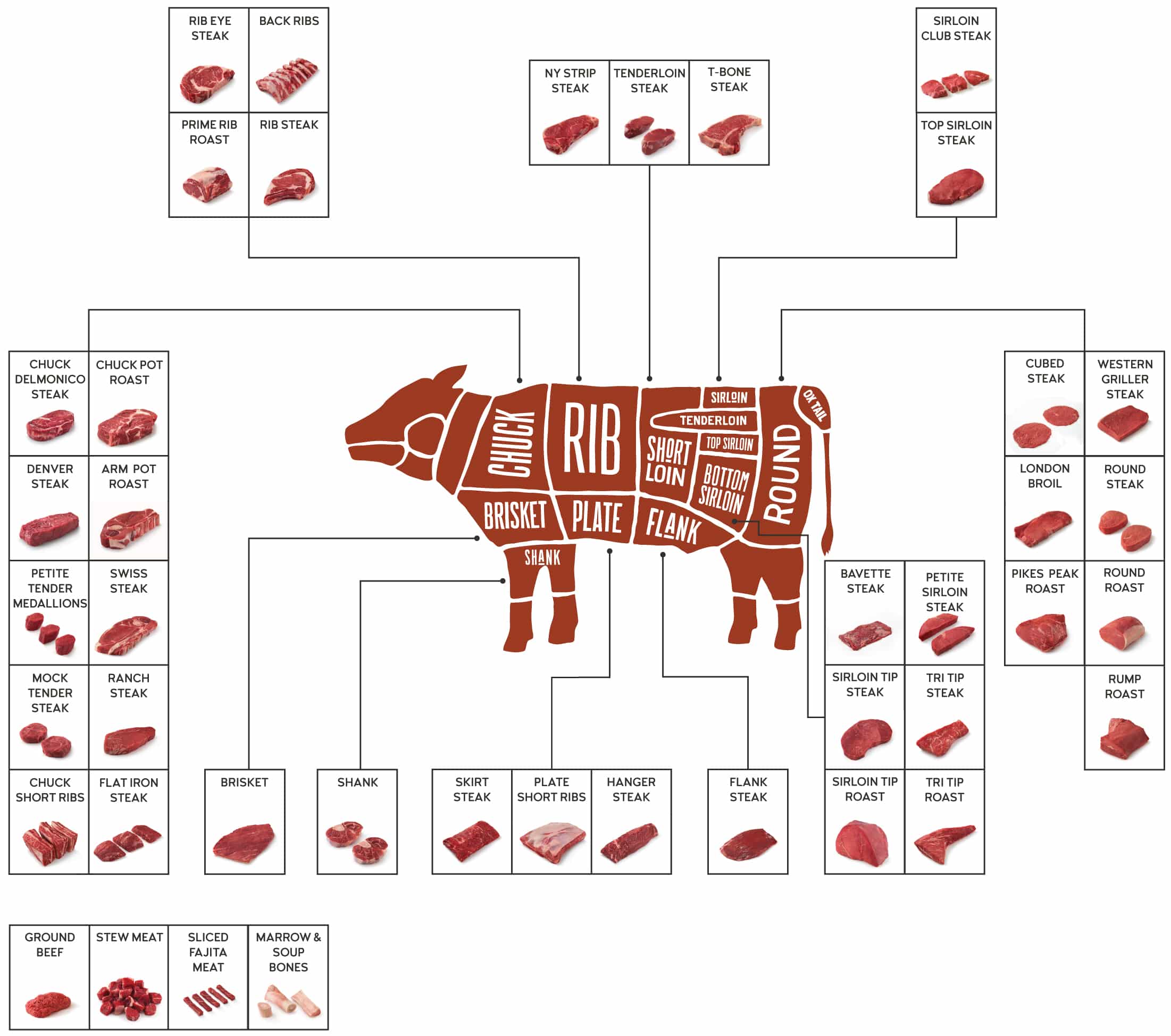- Due to UPS holiday closures, December 17 is our last shipping day of 2024. We resume shipping on January 6.
Explore Every Primal Cut with Our
beef cuts diagram
Every side of beef is initially broken down into primal cuts of beef – large sections that are then trimmed into the retail cuts you see in the butcher case. These primal cuts include the chuck, rib, loin, round, brisket, plate, flank, and shank. Knowing where your beef comes from helps you choose the right cut for every recipe, whether you’re slow-roasting, grilling, or braising.
Our easy-to-read beef cuts diagram breaks down each primal cut of beef into its retail cuts, making it simple to understand what comes from where. This guide is perfect for meal planning, shopping, or simply getting to know the beef in your freezer.
Knowing the characteristics of each beef primal cut ensures you choose the right cut for your recipe. Our detailed beef cuts diagram reflects the real-life butchering process we use on the ranch, ensuring nothing goes to waste and every cut finds its place at your table.

The Nine Beef Primal Cuts
Chuck Beef Primal
The beef chuck primal comes from the forequarter of the steer, from the base of the neck down through the upper arm. Chuck cuts are known for their super forward beefy flavors - this is due large in part to the high fat content. Chuck meat is usually turned into ground beef but it also features cuts that are great for stews and roasts.
Popular cuts from chuck include flat iron steak, Denver steak, and ground beef for hamburgers, all cuts that are best grilled, sauteed, or broiled. Because of the high fat content, chuck roasts and short ribs should be roasted or braised low and slow so the fat can render and break down, adding big flavor to your finished dish.
Chuck Primal Cuts of Beef
Short Ribs, Boneless
Arm Roast
Rib Beef Primal
Rib cuts are taken from the cow’s backbone and upper ribs. Only the last 6 to 12 ribs are included in the primal rib cut. Rib cuts are known for significant marbling, which results in their tenderness and rich, beefy flavor.
Rib cuts lend themselves to a variety of cooking methods. For example, rib eye steaks are best grilled or broiled, while short ribs are best braised, back ribs should be marinated or slathered with a dry rub, then grilled or smoked, and prime rib roasts shine when roasted or smoked.
Rib Primal Cuts of Beef
Rib Eye Steak, Bone-In
Loin Beef Primal
The loin primal is located just behind the ribs, at the top part of the animal. The cuts from the loin are highly regarded as some of the most tender on the entire animal, including the tenderloin, NY Strip Steak, T-Bone, and Porterhouse Steaks. Loin cuts are all quite lean, naturally tender, and have robust flavor.
Grilling or broiling is the best way to cook cuts from the loin, seared with direct high heat to lock in the juices. All loin cuts should be allowed to rest for two to five minutes after cooking, to allow the juices to redistribute throughout the steak.
Loin Primal Cuts of Beef
- T-Bone Steak
- Porterhouse Steak
Sirloin Beef Primal
The sirloin primal is the rear-most cut of the loin region and the cuts from this primal are naturally lean. Sirloin cuts are typically best for grilling or roasting, and rarely used for slow cooking.
The top sirloin yields steak, which are great for grilling including the petite sirloin steak and sirloin tip steaks, while the bottom sirloin features the tri-tip steak and roast, and the bavette steak, all great for roasting or grilling.
Sirloin Primal Cuts of Beef
Tri Tip, Roast
Sirloin Tip Roast
Round Beef Primal
The round primal is the hind leg of beef that extends from the rump down to the shanks. Round cuts are some of the most inexpensive beef cuts you can find and are typically very lean and lack tenderness.
Cuts from the round primal are used for pot roasts, stews, an bottom and top round roasts, perfect for slicing and using in roast beef sandwiches. Many portions of the round primal are used for ground beef.
Additionally, most jerky is made from this primal because of the minimal fat content and the larger size of these cuts.
Round Primal Cuts of Beef
Shank Beef Primal
The shank primal includes the fore-shank and hind-shank and comes from the legs of the animal. Foreshanks come from the animal's front legs from the area above the knee to the shoulder, while hind-shanks are taken from the rear, from the knee to the hip. Because they are heavily exercised muscles, the shanks are lean, tough cuts of meat. They are typically cut into cross sections of various widths and are best braised.
A popular dish that uses the cross-cut shank is Osso Buco. It's a braised dish made with shanks, vegetables, broth, and white wine. Shank bones are an excellent choice when creating hearty and flavorful bone broths, stews, and soups.
Shank Primal Cuts of Beef
Shank, center-cut
Flank Beef Primal
The flank primal is found on the belly of the animal and includes the Flank Steak, a thin, lean cut of meat. It is also a well exercised muscle and the meat fibers are tight-grained. Flank steak is boneless and when trimmed properly should feature very little fat.
Flank steak is best marinated for at least four hours with an acidic component that will help tenderize the meat. After marinating, it's great grilled or broiled and then cut across the grain to serve. This is one cut that shouldn't be cooked beyond medium rare so it doesn't become tough and dry.
Flank Primal Cuts of Beef
Plate Beef Primal
The plate primal is found in the abdomen area of the animal, right under the rib primal. Plate cuts tend to have a tight grain structure and are fattier than rib cuts. Cuts from this primal include the hanger steak, short ribs, and skirt steak.
The skirt steak especially is a thin, flavorful cut that's best when marinated, then quickly seared or grilled over high heat and cut against the grain. The hanger steak and short ribs are cuts that can also be marinated, or coated with a dry rub for up to two hours before cooking, again over high heat.
Plate Primal Cuts of Beef
Short Ribs, Bone-In
Brisket Beef Primal
The brisket primal is taken from the breast section of the animal under the first five ribs. It is usually sold boneless with the deckle, or point, removed and is referred to as the brisket flat cut. It is leaner and lies relatively flat for cooking. This primal contains lots of connective tissues (collagen) which when smoked for long periods of time render into gelatin, imparting the juiciness brisket is known for.
Brisket needs to cook low and slow for an extended period of time. Many consider this to be the best cut of beef from the entire animal. Brisket, when brined, is corned beef or pastrami. It's more affordable than rib eye steak or tenderloin steak because it is a heavily exercised, tough muscle, perfectly suited to low, slow cooking.






